Fashion
Brigitte Macron Dazzles in Elegant Blue Gown at State Banquet With Danish Royals
Published
3 days agoon

Brigitte Macron, the First Lady of France, accompanied her husband, President Emmanuel Macron, as they welcomed King Frederik X and Queen Mary of Denmark for a grand state banquet at the Élysée Palace in Paris. The Danish monarchs are in France as part of the “Denmark – France: Partnering for a Resilient Europe for the Future” initiative, where discussions on renewable energy, cultural collaboration, and other diplomatic matters are taking center stage.
For the distinguished evening, Brigitte Macron exuded sophistication in a royal blue column gown that featured sheer sleeves and delicate shimmering embellishments. Her choice of attire continued her well-known preference for blue hues, adding a refined yet modern sparkle to the ensemble. The elegant gown was adorned with strategically placed sparkling accents across the bodice, while the lower half showcased an intricate embroidered pattern, adding a regal touch to the outfit. The long sleeves were further accentuated with silver glittering details along the cuffs and hemline, lending a contemporary elegance to her look.
Complementing her attire, Macron opted for pointed-toe metallic silver heels, which subtly enhanced the shimmer of her dress. She accessorized minimally, selecting only a pair of striking statement earrings while foregoing other jewelry to allow her gown to remain the focal point of her ensemble.

Her hairstyle for the evening was a sleek chignon, with a few delicate strands framing her face, adding softness to her structured updo. Her makeup featured a refined smokey eye paired with a neutral lip color, ensuring a polished and timeless look.
The state dinner also saw a stunning contrast between the fashion choices of France’s First Lady and Queen Mary of Denmark. The Danish Queen opted for a more traditional yet equally elegant ensemble, wearing a high-waisted voluminous skirt adorned with cascading floral patterns. She paired this with a white blouse that featured a high neckline, delicate embroidery, and billowing sleeves cinched at the cuffs, presenting a graceful and regal aesthetic.
Brigitte Macron’s latest appearance further solidified her signature style, which often includes an affinity for blue hues. Whether attending formal events or opting for chic business attire, she consistently incorporates this classic color into her wardrobe, reinforcing her reputation for timeless elegance.
This grand diplomatic event was not only a showcase of international relations but also a platform for refined fashion statements. Brigitte Macron and Queen Mary of Denmark each brought their own distinctive styles to the evening, embodying grace, poise, and sophistication.
Sahil Sachdeva is the CEO of Level Up Holdings, a Personal Branding agency. He creates elite personal brands through social media growth and top tier press features.

You may like
Fashion
Vivienne Westwood Brings Indian Textiles to Life at the Gateway of India in a Stunning Couture Showcase
Published
11 hours agoon
April 4, 2025
Against the majestic backdrop of the Arabian Sea and the historic Gateway of India, British fashion house Vivienne Westwood made a powerful debut on Indian soil this week, unveiling a couture collection rooted in Indian handloom traditions. The show marked a striking confluence of global design and local craftsmanship, with khadi and chanderi—two of India’s most iconic textiles—at the heart of a 60-piece collection that celebrated heritage, sustainability, and innovation.
Hosted in collaboration with the Department of Textiles, Government of Maharashtra, and Viz Fashion School Pvt. Ltd., the event drew the city’s elite, along with Bollywood’s fashion-forward stars, to the rain-slicked and scaffold-draped monument. While the temporary construction couldn’t dampen the energy, the weather added an unexpected element to the evening. A passing rain shower misted the audience as they sat in the humid Mumbai air, eager for a glimpse of Vivienne Westwood’s spring/summer 2025 collection.
The collection was a striking blend of textures and silhouettes, honouring Indian heritage while staying true to Westwood’s bold aesthetic. Using khadi—once a symbol of India’s independence movement championed by Mahatma Gandhi—and chanderi silks sourced from Madhya Pradesh, the garments reflected the evolution of Indian textiles. From crisp white muslin to deep violet raw silks and sand-toned Muga, every piece was designed to showcase the soul of the fabric, whether through sharp tailoring, graceful drapes, or dramatic sculpting.
“This show isn’t just about fashion—it’s about philosophy, story, and shared history,” said Carlo D’Amario, CEO of Vivienne Westwood. “Celebrating khadi is like celebrating the spirit of Mahatma Gandhi. In a world chasing artificial change, these fabrics remind us of what’s pure and essential.”
D’Amario, deeply moved by his past travels in India, called the event a dream realised. He had long envisioned staging a show that would connect Westwood’s enduring commitment to craftsmanship with India’s rich textile legacy. The result was a show that fused the ethos of the East with the punk-tinged elegance of the West.
Among the crowd were celebrities who embraced the collection’s eclectic spirit. Kareena Kapoor Khan, Janhvi Kapoor, Bhumi Pednekar, Aditya Roy Kapur, and Manushi Chhillar were among those who dazzled in customised Westwood looks. One of the most striking ensembles of the evening came from Radhika Merchant Ambani, who blended cultures effortlessly by pairing a Westwood archival corset with a bespoke sari. Designer Manish Malhotra, too, showed support by donning the British label.
Behind the collection was a long and intricate journey. According to Dr. Arti Rai, founder and director of Vivz Fashion School, the seeds were planted two years ago during a conversation with D’Amario. “He was very clear: he wanted khadi, and he wanted the Gateway of India,” she shared. The collaboration involved months of engagement with Khadi India, the Khadi board, and Aaranya in Gwalior, ensuring authentic sourcing and direct benefit to artisans.

Vivienne Westwood Brings Indian Textiles to Life at the…
Aaranya’s founder, Maharani Priyadarshini Raje Scindia, played a crucial role in connecting the brand with weavers in Chanderi, helping bridge the gap between centuries-old traditions and contemporary couture. “They didn’t just want the fabric—they wanted the story, the history, the people,” she noted. “There were real conversations, real meetings with artisans. It was about empowerment as much as aesthetics.”
The result was a subdued elegance—cleaner lines, fewer motifs, and natural dyes that allowed the fabric to speak for itself. While chanderi’s delicate weave can be difficult to manipulate, Westwood’s atelier managed to create dramatic gowns inspired by Victorian silhouettes, reshaping Indian textiles into international high fashion.
“It’s not an easy fabric to work with,” Scindia said, “but to see it transformed into structured gowns was eye-opening. The results were both experimental and deeply respectful.”
The absence of creative director Andreas Kronthaler, Westwood’s widower, was felt but not dwelled upon. In many ways, the show was a homage not just to India, but to the legacy of Vivienne Westwood herself—her commitment to sustainability, her rebellion against conformity, and her reverence for heritage.
Kareena Kapoor Khan captured the evening’s sentiment perfectly in her remarks after the show: “Indian craftsmanship has always made waves globally. But to see a brand like Vivienne Westwood come here and not just show, but collaborate meaningfully with our textiles—it’s a very proud moment. This feels like the beginning of something much bigger.”
Indeed, the momentum may just be starting. While Western brands have historically eyed India with cautious curiosity, recent high-profile shows—first Dior, and now Westwood—signal a shift toward more authentic engagement with Indian artistry. However, some experts caution that fashion is still a niche space in India’s luxury market, dominated largely by beauty, fragrances, and accessories.
“India is a growing market, but the footprint for luxury fashion is still small,” noted Pankaj Renjhen, joint managing director at Anarock Retail. “This kind of collaboration is great for storytelling and market testing—but there’s still a long journey ahead.”
Nevertheless, D’Amario remains optimistic. When asked about future plans, he hinted, “This was just the beginning. We need to do something more, together. Very soon.”
And with that, Vivienne Westwood has firmly planted a flag on Indian soil—not just as a guest, but as a brand ready to collaborate, celebrate, and co-create with the subcontinent’s extraordinary textile legacy.
Fashion
American Designer Jeremy Scott Brings His Signature Style to Berlin’s Friedrichstadt-Palast
Published
2 days agoon
April 3, 2025
American fashion designer Jeremy Scott is set to dazzle Berlin’s theatrical scene with an extravagant display of his creativity. Known for his bold and unconventional approach to fashion, Scott has been commissioned to design an impressive 500 costumes for Friedrichstadt-Palast’s upcoming cabaret-style revue, Blinded by Delight, premiering on September 24. The show promises to be a feast for the senses, celebrating joy, spectacle, and escapism in grand style.
Scott, famous for merging haute couture with pop culture, expressed his excitement about the project, describing fashion as a gateway to another world—a temporary escape from reality. “My designs are filled with dreams, inspiration, and loads of love that I hope will inspire, delight, and enchant the imagination of the guests,” he shared.
Following in the footsteps of iconic designers like Jean Paul Gaultier, who curated the visual direction for Friedrichstadt-Palast’s Falling | In Love, Scott is set to bring his own unique flair to the venue’s latest production. Blinded by Delight is described as a mesmerising spectacle that will immerse audiences in a vibrant, euphoric world. The production features more than 100 performers, including singers, dancers, and acrobats, all utilising the largest theatrical stage in Europe. The revue’s grand scale is matched by its nearly 14 million euro production budget, making it one of the most ambitious performances in recent years.

American Designer Jeremy Scott Brings His Signature Style…
Scott’s history of theatrical showmanship makes him a fitting choice for this high-profile endeavour. His tenure as Moschino’s creative director saw him push the boundaries of fashion, transforming runways into immersive experiences. One of his most memorable showcases mirrored an American game show, complete with elaborate set designs and whimsical prizes. His departure from Moschino in 2023 left fans wondering what his next venture would be, and now, with Blinded by Delight, he is set to redefine theatrical costuming with his signature blend of extravagance and playfulness.
The Friedrichstadt-Palast, a state theatre owned by the City of Berlin, has a storied tradition of producing breathtaking revues that blend elements of Moulin Rouge, Cirque du Soleil, and rock concerts. Each new production seeks to outdo the last, and Blinded by Delight is poised to be a standout moment in the venue’s rich history.
Scott’s return to the limelight extends beyond his work for the stage. Since stepping away from Moschino, he has collaborated with beauty brand SpoiledChild, designing futuristic, space-inspired packaging for their skincare and haircare products. His work in fashion spans decades, from launching his own label in Paris in 1997 to creating eccentric, playful collaborations with brands like Adidas Originals, Longchamp, and Swatch. Whether designing sneakers adorned with teddy bears and leopard tails or reimagining eyewear for Linda Farrow, Scott has always pushed the boundaries of fashion, infusing it with humour and fantasy.
Beyond fashion, Scott also ventured into filmmaking during the pandemic, directing a musical short film for Moschino’s 2022 resort collection. The film, starring model-turned-singer Karen Elson, was shot on the iconic Universal Studios backlot in Los Angeles and transformed into a vibrant, retro jukebox diner. His ability to translate fashion into cinematic storytelling further underscores his talent for spectacle, making him an ideal creative force behind Blinded by Delight.
Berlin’s Friedrichstadt-Palast has long been a beacon of grandeur and spectacle in the performing arts world, and with Jeremy Scott at the helm of costume design, Blinded by Delight promises to be a visual and artistic triumph. Audiences can expect a whirlwind of dazzling fabrics, bold colours, and larger-than-life aesthetics, all wrapped in Scott’s inimitable sense of fun and fantasy.
As anticipation builds for the September debut, one thing is certain: Jeremy Scott’s vision will transform the stage into a vibrant dreamscape, proving once again that fashion and performance are a match made in theatrical heaven.
Fashion
Inside Chanel’s Leather Atelier: The Craftsmanship Behind the Iconic Handbag
Published
2 days agoon
April 2, 2025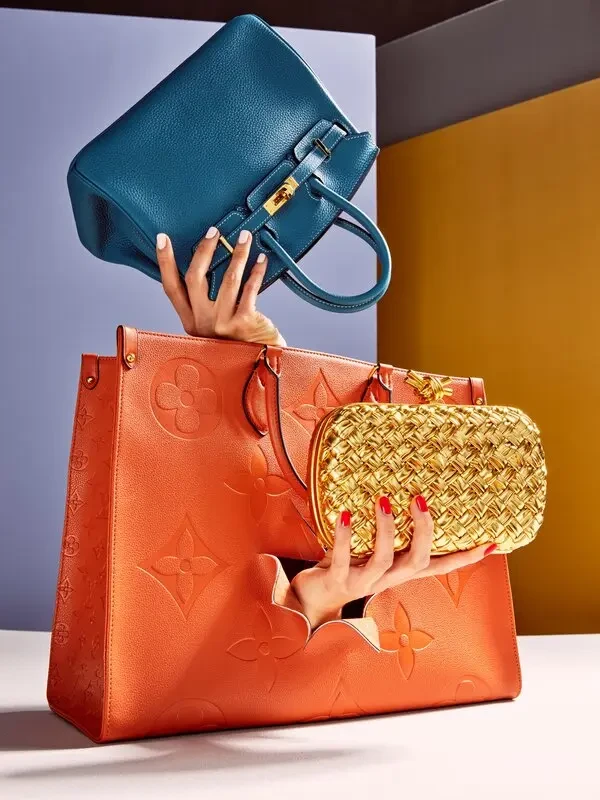
In a rare behind-the-scenes glimpse, Chanel has opened the doors to one of its premier leather goods factories in Verneuil-en-Halatte, France. This move, part of the luxury brand’s strategy to highlight the artistry behind its famed handbags, comes in response to market challenges, including fluctuating luxury spending and scrutiny over rising prices. The $10,000 price tag of Chanel’s classic flap bag has long sparked curiosity, and now, the brand is shedding light on what justifies its cost.
A Legacy of Craftsmanship
Chanel’s classic handbag is one of the brand’s most revered creations, standing alongside its No. 5 perfume as an enduring symbol of luxury. Bruno Pavlovsky, president of Chanel SAS, emphasizes the importance of showcasing the skill and dedication involved in crafting each piece. While Chanel has long relied on a mix of independent suppliers and in-house production, it now manufactures two-thirds of its bags in company-controlled factories, ensuring strict quality control and preserving artisanal expertise.
Unlike competitor Hermès, which operates solely through its own workshops, Chanel maintains long-standing partnerships with independent manufacturers. This balance, Pavlovsky explains, helps the brand remain attuned to market trends while safeguarding traditional techniques.
Inside Les Ateliers de Verneuil-en-Halatte
The Verneuil-en-Halatte facility, a key production site an hour and a half from Paris, embodies Chanel’s commitment to sustainability and excellence. Established in 1990 and relocated to its current state-of-the-art premises in 2021, the 270,000-square-foot factory operates with an emphasis on environmental responsibility. Solar panels contribute to its energy supply, while spacious, well-lit workshops provide optimal working conditions for the 470 artisans employed there.
The production process of Chanel’s 11.12 handbag—a modern take on the 2.55 design introduced by Coco Chanel in 1955—unfolds across 180 meticulous steps. Unlike Hermès, where a single artisan crafts an entire bag, Chanel employs a collaborative approach, with around 30 specialists contributing to each piece. Artisans specialise in various stages, from cutting and assembling to finishing touches like braiding the signature leather-and-chain strap.

Inside Chanel’s Leather Atelier: The Craftsmanship Behind
Training the Next Generation
With craftsmanship at its core, Chanel invests heavily in training new artisans. The on-site training school at Verneuil-en-Halatte accepts ten apprentices at a time, providing hands-on education under the guidance of experienced mentors. Employees, who range in age from 18 to 65, often come from diverse backgrounds, including former florists and carpenters seeking a career shift. To counteract industry-wide labor shortages, Chanel recruits both young talent and individuals looking for mid-career transitions, aligning with broader employment initiatives in France.
The brand’s efforts to maintain a skilled workforce reflect a broader shift in employee expectations post-pandemic. Pavlovsky acknowledges that younger artisans demand better wages and flexible work conditions, factors Chanel must accommodate while upholding its commitment to quality.
Sourcing and Sustainability
Each Chanel bag is crafted from carefully sourced materials, with leather originating from traceable, sustainable supply chains in France, Italy, and Spain. The Verneuil-en-Halatte workshop houses an extensive materials archive, including 900 leather and fabric references and over 1,100 types of hardware and thread. Leather offcuts are repurposed for prototype development and shoe production, aligning with Chanel’s sustainability goals.
Beyond production, the facility features a dedicated research lab where materials and finished products undergo rigorous testing. A repair workshop ensures longevity, restoring well-loved bags, including those that have endured the wear and tear of daily life.
Bridging Heritage and Innovation
Chanel’s dedication to craftsmanship extends beyond tradition to continuous innovation. The design workshop at Verneuil-en-Halatte works closely with Chanel’s creative teams in Paris to develop seasonal collections, often incorporating novel materials like tweed and embroidery from the brand’s specialised craftsmanship hub, Le19M.
This commitment to fashion-driven leather goods sets Chanel apart. The workshop produces eight collections annually, keeping pace with Chanel’s ready-to-wear designs. Recent launches, including the 25-bag, have been backed by high-profile campaigns featuring global icons like Dua Lipa and Blackpink’s Jennie Kim.
The Future of Luxury Pricing
Chanel’s pricing strategy has been a topic of debate, with the Medium Classic bag rising from $5,800 in 2019 to $10,800 in 2025. The brand attributes these increases to inflation, raw material costs, and global price harmonisation. While the euro price is adjusted annually, currency fluctuations also play a role in determining costs worldwide.
Looking ahead, Chanel plans to enhance transparency further with digital product passports. These will provide consumers with detailed information on a product’s materials, origin, and environmental impact, in line with new European Union regulations. This initiative underscores the brand’s evolving approach—preserving heritage while adapting to modern expectations.
A Glimpse into the Future
By opening its doors, Chanel is not just revealing the intricacies of its craftsmanship; it’s reinforcing the value behind its luxury pricing. As the fashion landscape shifts, the blend of tradition, innovation, and transparency will define the future of high-end leather goods. Chanel’s timeless handbags remain a testament to the artistry and dedication that elevate them beyond mere accessories into the realm of iconic investment pieces.
Fashion
Julia Garner Stars in Gucci’s Tribute to Silk Craftsmanship
Published
5 days agoon
March 31, 2025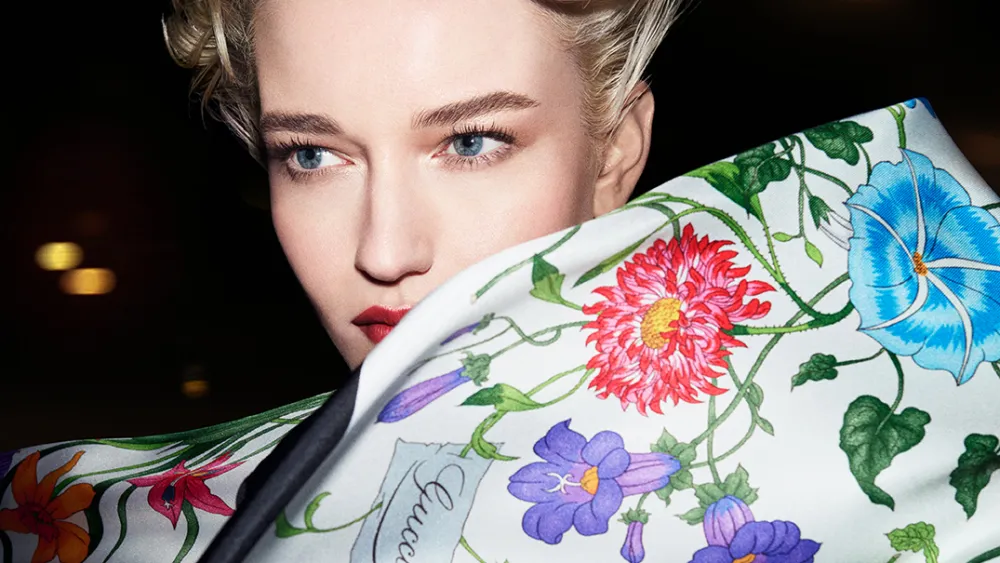
Gucci has once again paid homage to its long-standing heritage in silk craftsmanship through a striking new campaign. Featuring award-winning actress Julia Garner, the “Keep It Gucci: The Art of Silk” campaign beautifully showcases the luxury brand’s commitment to artistic excellence and innovation in fabric design.
A Celebration of Gucci’s Silk Legacy
Gucci, known for its rich history in fashion and textiles, marks an important chapter in its journey with this latest initiative. This campaign is part of the larger “The Art of Silk” project, which delves into the brand’s expertise in silk production. It highlights Gucci’s evolution in fabric artistry, which has spanned over a century. Garner, a close collaborator with the fashion house, embodies the brand’s modern yet timeless appeal in this elegant series of images.
Photographed by the renowned Steven Meisel, the campaign presents an evocative and cinematic portrayal of Gucci’s iconic silk scarves. Garner is seen posing against a moody, nighttime cityscape, with luxurious silk foulards wrapped around her head and neck. Each image in the series draws attention to the exquisite patterns and intricate designs that have cemented Gucci’s reputation in the fashion industry.
The “90×90” Project and Artistic Innovation
At the heart of this initiative lies the “90×90” project, a creative endeavor that invited artists from around the world to reimagine five signature themes from Gucci’s silk archives. These themes—flora, fauna, nautical, equestrian, and the iconic GG monogram—have been integral to Gucci’s identity over the decades. This project not only showcases the historical significance of these patterns but also breathes new life into them through fresh artistic interpretations.
Adding to the celebration of silk, Gucci has collaborated with luxury publisher Assouline to produce a book titled Gucci: The Art of Silk. This publication offers an in-depth look at the brand’s expertise, tracing the evolution of its silk craftsmanship and the cultural significance of its most renowned designs.

The Iconic Gucci Silk Motifs
Garner’s campaign highlights an array of signature motifs that have played a defining role in Gucci’s design legacy. One of the most notable is the Flora pattern, originally designed in 1966 by illustrator Vittorio Accornero de Testa. Commissioned to create a vibrant and elaborate floral print for Princess Grace of Monaco, Accornero crafted a masterpiece featuring 43 varieties of hand-painted flowers, plants, and insects. This pattern has since become one of Gucci’s most cherished designs, appearing on scarves, dresses, and accessories throughout the years.
Other timeless motifs showcased in the campaign include the Gucci stirrup print, the Horsebit pattern, and the classic GG monogram. Each of these designs reflects the brand’s deep-rooted connection to equestrian themes and Italian luxury craftsmanship. Through this campaign, Gucci reaffirms its ability to blend heritage with modern aesthetics, ensuring that its legacy remains relevant in contemporary fashion.
Gucci’s Silk Journey: From the 1950s to Today
Gucci’s expertise in silk dates back to the 1950s, when the brand first began producing silk scarves inspired by its renowned leather goods. The earliest documented Gucci scarf, created in 1958, featured a nautical-themed design called Tolda di Nave (translated as “Deck of a Ship”). Produced in Como, Italy—a region known for its silk production—this design set the stage for Gucci’s enduring influence in luxury textiles.
Over the decades, Gucci has continued to innovate, incorporating new techniques and patterns while staying true to its artistic roots. The “Keep It Gucci: The Art of Silk” campaign serves as a testament to the brand’s dedication to preserving and evolving this craftsmanship.
Exclusive Events and Launch in Paris
To further celebrate its silk heritage, Gucci is set to host a series of special events in Paris. The Rue Saint-Honoré boutique will serve as the venue for an exclusive activation dedicated to “The Art of Silk” project. Additionally, a high-profile dinner event will honor the campaign, bringing together industry insiders, artists, and fashion enthusiasts to commemorate this milestone.
Coinciding with these celebrations, Gucci has launched a collection of “90×90” scarves, which are now available for purchase. These pieces embody the brand’s rich history while offering a fresh take on its beloved designs.
A Timeless Tribute to Elegance
With Julia Garner as the face of this campaign, Gucci has successfully blended cinematic storytelling with high-fashion artistry. The campaign not only reinforces the brand’s reputation for excellence in silk craftsmanship but also serves as a reminder of the timeless allure of its signature designs.
Through “The Art of Silk” project, Gucci continues to honor its past while shaping the future of luxury fashion. Whether through artful collaborations, immersive experiences, or exquisite new collections, the brand remains a powerful force in the world of high-end textiles and design.
Fashion
The Rise of the “Quiet Luxury” Trend: How Minimalist Elegance is Redefining American Fashion
Published
3 weeks agoon
March 13, 2025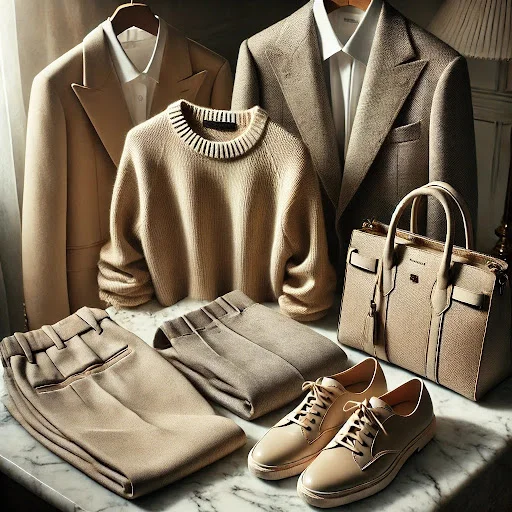
In a world dominated by flashy logos and bold branding, a new fashion movement is taking over—Quiet Luxury. This trend, emphasizing understated elegance and high-quality craftsmanship, has gained massive popularity in the United States. Fueled by social media, celebrity endorsements, and a shift towards timeless fashion, Quiet Luxury is redefining how Americans perceive style.
What is Quiet Luxury?
Quiet Luxury is all about refined, high-end fashion without loud branding. Think of tailored blazers, cashmere sweaters, and elegant neutral palettes. Unlike past trends where designer logos were front and center, this aesthetic prioritizes quality and craftsmanship over name recognition.
Luxury fashion houses like Brunello Cucinelli, The Row, and Loro Piana have championed this trend, creating pieces that exude sophistication without the need for branding. Even mainstream brands have started embracing this shift, offering minimalist yet high-quality collections.
Why is Quiet Luxury Trending?
Several factors have contributed to the rise of this movement:
- The “Old Money” Aesthetic: TV shows like Succession have glamorized the discreet style of the ultra-rich. Characters dress in expensive but low-key outfits, influencing audiences to adopt the same aesthetic. This has given rise to hashtags like #OldMoneyStyle and #QuietLuxury on platforms like TikTok and Instagram.
- Shift in Consumer Priorities: Post-pandemic, many Americans prefer fewer, better-quality items over fast fashion. Sustainability concerns have also driven people towards investment pieces rather than mass-produced clothing.
- Celebrity Influence: A-listers like Zendaya, Sofia Richie, and Gwyneth Paltrow have embraced Quiet Luxury, making it more aspirational. Even fashion-forward figures like Hailey Bieber have swapped flashy logos for timeless essentials, proving that elegance speaks louder than labels.
How Social Media is Driving the Trend
Social media has played a pivotal role in popularizing Quiet Luxury. Influencers and fashion enthusiasts now create content around capsule wardrobes, neutral aesthetics, and timeless investments.
Additionally, TikTok has been flooded with videos comparing “stealth wealth” outfits to logo-heavy fashion, reinforcing the idea that true luxury doesn’t need validation.
Is Quiet Luxury Here to Stay?
Unlike short-lived fashion trends, Quiet Luxury aligns with timelessness and sustainability, making it a movement rather than a passing phase. With the ongoing focus on minimalism, ethical shopping, and elevated basics, Quiet Luxury is expected to dominate fashion for years to come.
As more consumers gravitate towards quality over quantity, brands will need to adapt by producing well-crafted, durable, and sophisticated pieces rather than chasing viral trends.
Quiet Luxury is redefining American fashion by prioritizing understated elegance, impeccable tailoring, and sustainable choices. Whether through minimalist power dressing or well-made everyday staples, this trend signals a cultural shift in how we approach style.
As the movement continues to gain momentum, one thing is clear—real luxury isn’t about being seen; it’s about being felt.
Fashion
Balenciaga and Bottega Veneta: The Rise and Risks of Paparazzi-Inspired Fashion Campaigns
Published
2 months agoon
February 3, 2025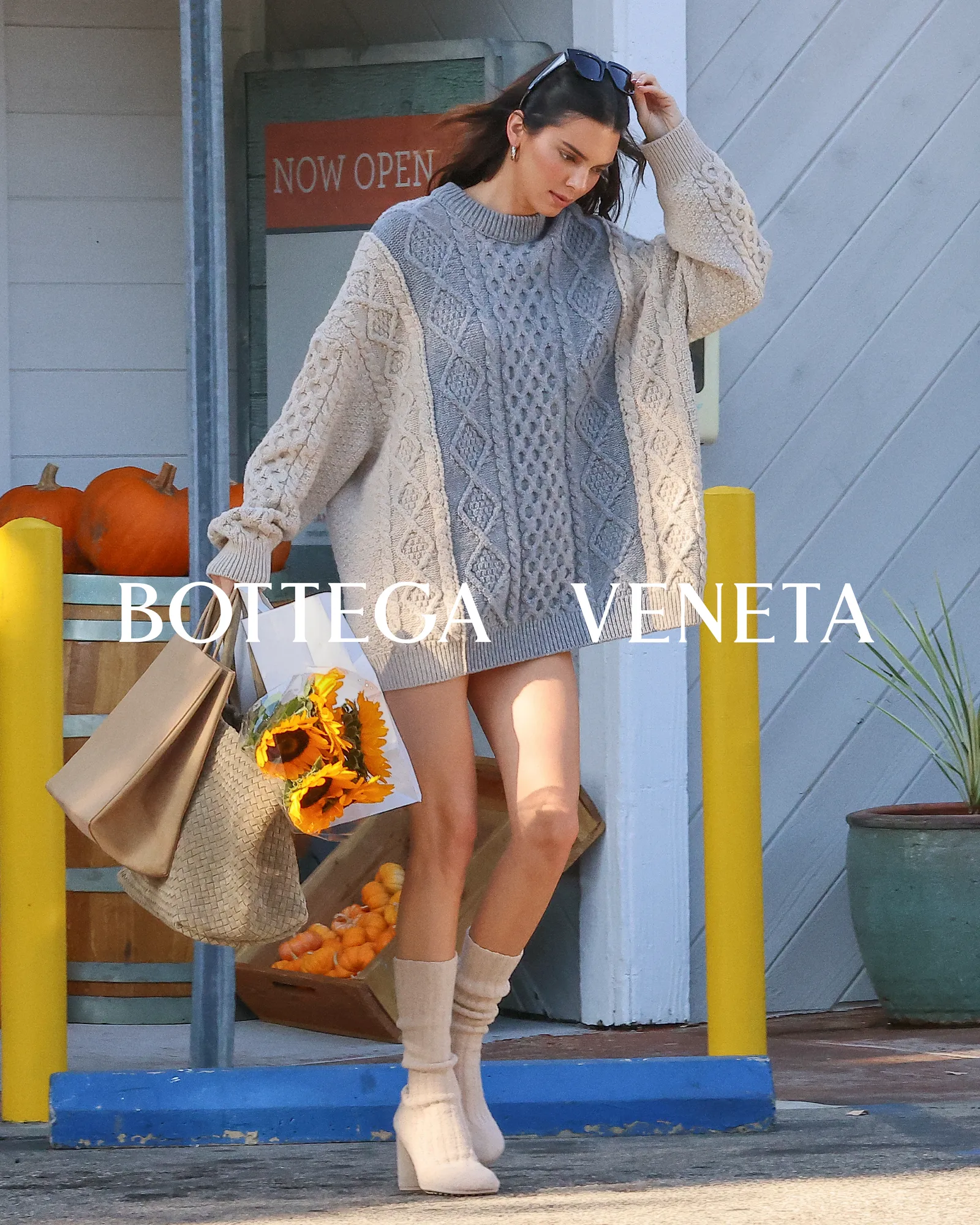
In recent times, fashion brands have increasingly embraced the use of paparazzi-style campaigns as a way to blend celebrity culture with marketing strategies. By tapping into the appeal of candid celebrity moments, these campaigns aim to establish a sense of authenticity and relatability. However, as this trend becomes more widespread, questions surrounding its originality and effectiveness are emerging.
Balenciaga’s ‘Le City Paparazzi’ Campaign
In January 2025, Balenciaga debuted its ‘Le City Paparazzi’ campaign, which creatively blends vintage paparazzi photos from the early 2000s with the brand’s modern Le City Bag. The campaign features iconic supermodels like Natasha Poly, Tyra Banks, Amber Valletta, and Paris Hilton, digitally placed into these retro photographs. This fusion of past and present emphasises the lasting impact of the Le City Bag and the celebrities who made it iconic.
While this campaign effectively taps into a sense of nostalgia, it also highlights the growing use of paparazzi-style imagery in fashion marketing. This approach aims to convey a sense of spontaneity and real-life glamour, reflecting the deep integration of celebrity culture into modern media.
Bottega Veneta’s Approach to Paparazzi-Style Marketing
Bottega Veneta has similarly jumped on this trend. In late 2023, the brand worked with high-profile celebrities like Kendall Jenner and A$AP Rocky, capturing them in paparazzi-style photos. These images were then licensed from well-known agencies such as Getty and Backgrid, blurring the lines between organic celebrity moments and calculated marketing content.
This shift in strategy reflects changing consumer expectations. Today, audiences want to feel a connection with celebrities in more everyday, relatable situations rather than through the polished images of traditional ads. By presenting products in these ‘real-life’ contexts, brands hope to create a stronger emotional bond with their consumers.
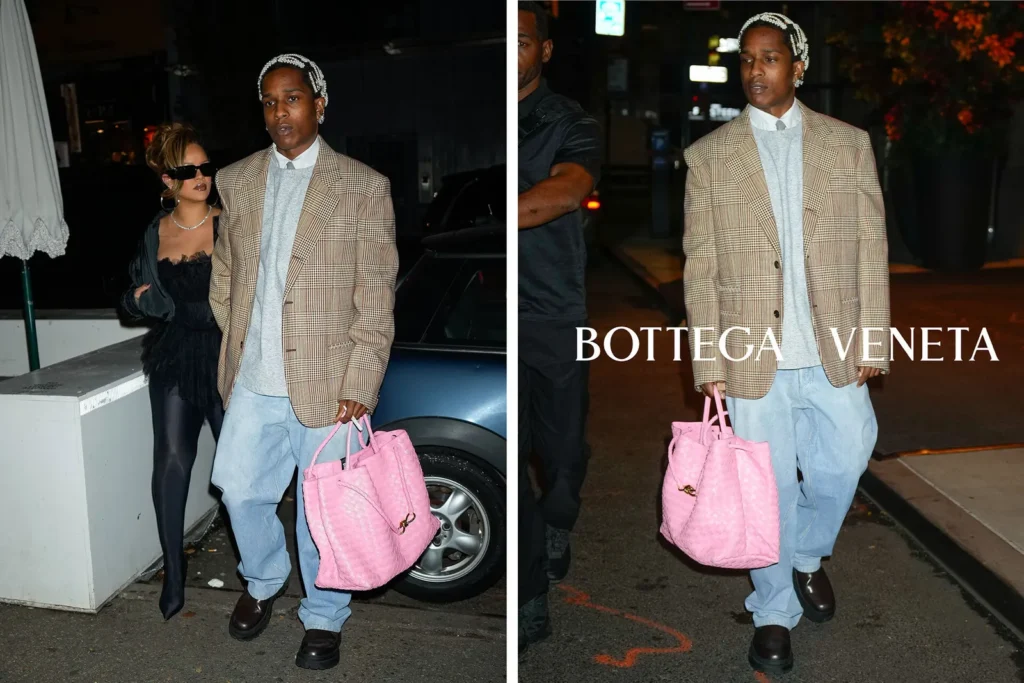
The Rise and Impact of Paparazzi Campaigns
The use of paparazzi imagery in fashion campaigns is not a new phenomenon. In 2006, Jimmy Choo featured Nicole Richie in a paparazzi-inspired shoot, capitalising on her popularity as a tabloid staple. This early example set a precedent for future campaigns that blend the worlds of celebrity culture and fashion marketing.
However, as this approach becomes increasingly common, its novelty has begun to wear off. Consumers are now more aware of the constructed nature of these ‘candid’ moments, leading to a sense of overexposure. For brands, the challenge lies in maintaining a balance between authenticity and marketing, ensuring that these campaigns continue to engage audiences without feeling disingenuous.
The Future of Paparazzi-Inspired Campaigns
As the fashion industry continues to navigate the intersection of celebrity culture and advertising, the use of paparazzi-style campaigns will likely continue to evolve. Brands will need to find new ways to present their products that feel both genuine and innovative, moving beyond the current trend in order to retain consumer interest and trust.
In conclusion, while paparazzi-inspired campaigns have become an integral tool in fashion marketing, their success will depend on the industry’s ability to adapt and innovate. As consumers become more discerning, brands will need to create campaigns that strike the right balance between engagement and authenticity, ensuring that the appeal of ‘candid’ celebrity moments remains a powerful marketing tool.
Fashion
How Trump’s Climate Policy Shifts Challenge Fashion’s Net-Zero Goals
Published
2 months agoon
January 23, 2025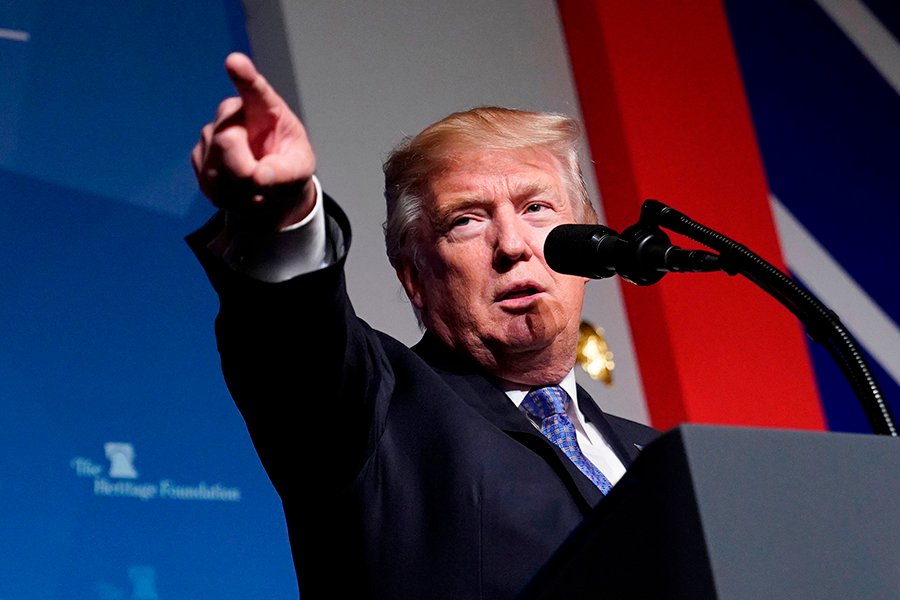
When President Donald Trump assumed office in January 2017, his first actions signaled a dramatic shift in U.S. climate policy, with long-lasting repercussions for global sustainability efforts. Among his early executive moves was the withdrawal of the U.S. from the Paris Agreement, a global pact aimed at limiting global warming to well below 2°C, ideally 1.5°C, to prevent the worst effects of climate change. For industries like fashion, whose global supply chains are intricately linked to international climate policies, these actions represented a significant setback. The fashion industry, already under pressure to reduce its environmental footprint, now faced the challenge of navigating a policy landscape that seemed increasingly hostile to sustainability goals.
U.S. Exit from Paris Agreement: Implications for Fashion and Global Climate Efforts
Trump’s decision to withdraw the U.S. from the Paris Agreement marked a crucial turning point in global climate diplomacy. Signed in 2016, the Paris Agreement sought to unite nations in the fight against climate change by setting ambitious emissions reduction targets. The U.S. exit complicated international cooperation, leaving a vacuum that made it harder for industries worldwide to align with global climate goals. For fashion, which accounts for a significant portion of global emissions, this decision was a blow to the progress made toward achieving net-zero emissions by mid-century. The U.S. withdrawal, particularly on the heels of its re-entry under President Biden, raised serious concerns about the future of global efforts to combat climate change and how industries like fashion would adapt to a shifting policy environment.
Fossil Fuel Focus vs. Sustainability: How Trump’s Actions Challenge the Fashion Industry
One of Trump’s defining policy goals was to revive and expand fossil fuel production, often championing the U.S. as an “energy dominant” nation. By loosening regulations on fossil fuel infrastructure and fast-tracking approvals for oil, gas, and power projects, Trump sought to stimulate growth in the U.S. energy sector. However, this vision of fossil fuel expansion stood in direct contrast to the growing global shift toward renewable energy and sustainable practices across industries. For the fashion industry, which is increasingly prioritising sustainability and responsible sourcing, Trump’s policies presented a challenge. As fossil fuel production surged, industries with high carbon footprints like fashion faced mounting pressure to reconcile their operations with a world that was increasingly focused on mitigating climate change. The fashion sector, which is particularly vulnerable to the impacts of climate change through disruptions in supply chains and resource availability, now found itself at odds with national policies that seemed more attuned to the interests of the fossil fuel industry than to those of environmentally conscious industries.
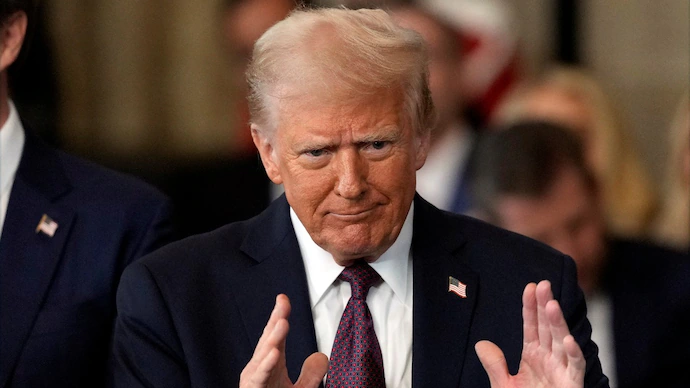
The Clash of Energy Dominance and Sustainability: Trump’s Impact on Fashion’s Future
Trump’s relentless push for “energy dominance” had a ripple effect on industries across the globe, including fashion. While fossil fuel production may have been seen as a short-term economic boon, the long-term environmental costs were becoming harder to ignore. The fashion industry, which has been making strides toward more sustainable practices, found itself navigating a complex landscape. On the one hand, the U.S. was retreating from global climate leadership, retreating from initiatives that would have made it easier for industries to transition toward cleaner alternatives. On the other hand, the global shift toward renewable energy and sustainability continued to gather momentum, with companies in fashion and other sectors increasingly adopting environmentally friendly practices to stay competitive. For fashion, the challenge now lay in balancing its sustainability commitments with the realities of a policy landscape that seemed increasingly out of step with global climate imperatives.
Global Climate in Crisis: Trump’s Policies Threaten Fashion’s Net-Zero Ambitions
Trump’s executive orders, including the U.S. exit from the Paris Agreement and efforts to roll back emissions regulations, directly threatened many of the climate initiatives that were set to drive the global transition toward sustainability. For the fashion industry, which has already been grappling with its environmental impact, these moves represented a major obstacle. Achieving net-zero emissions is a complex and long-term goal, particularly for an industry that relies on global supply chains and resource-intensive production processes. Trump’s rollback of environmental protections made it more difficult for fashion to align with global climate targets and further exacerbated the challenge of reaching the necessary levels of collaboration across countries to meet climate goals.
Energy Dominance vs. Clean Energy: Trump’s Legacy and Fashion’s Climate Challenges
While Trump’s policies favoured the fossil fuel industry, the global energy transition was making steady progress. Renewable energy technologies, such as solar and wind power, continued to fall in price and gain market share. In fact, many regions now find renewable energy to be the most cost-effective option for electricity generation. For industries like fashion, the transition toward cleaner energy sources became both a necessity and an opportunity. The pressure to adopt more sustainable practices has grown as the environmental impact of fashion production continues to rise. Trump’s focus on fossil fuels, however, threatened to slow down this transition by prioritising infrastructure that would extend the life of non-renewable energy sources, putting additional pressure on industries that had already begun moving toward cleaner alternatives.
Navigating Sustainability in Uncertain Times: The Impact of Trump’s Climate Policies on Fashion
As the U.S. reversed course on climate action, the fashion industry found itself caught in an uncertain policy environment. Fashion brands that had been making significant strides toward sustainability now had to contend with a government that appeared more interested in fostering fossil fuel production than in advancing policies to tackle climate change. For many companies, this uncertainty created challenges in setting long-term sustainability goals. Some brands, particularly those with global supply chains, found it increasingly difficult to align their practices with international climate commitments in the face of the U.S. pulling back from its leadership role. As a result, fashion had to adapt quickly to these new realities, relying on private sector resilience to continue pushing forward with its sustainability initiatives despite the changing political landscape.
Fashion and Fossil Fuels: How U.S. Policy Shifts Undermine Global Climate Goals
Trump’s aggressive stance on fossil fuels, including withdrawing from the Paris Agreement and easing regulations on drilling and emissions, posed a significant threat to the fashion industry’s ability to achieve sustainability. These policy shifts undermined global efforts to tackle climate change by signalling that the U.S. was no longer committed to addressing the climate crisis on the international stage. For industries like fashion, which are closely tied to global supply chains and reliant on international cooperation, the retreat of the U.S. from its climate commitments made it harder to achieve the ambitious emissions reductions necessary to meet the targets set by the Paris Agreement. The fashion sector, already grappling with its environmental impact, was left to navigate these new challenges as the global fight against climate change continued without full U.S. participation.
Trump’s Climate Agenda: What it Means for Fashion’s Path to Sustainability
Trump’s actions created significant uncertainty for industries like fashion that were striving to meet sustainability goals. The fashion industry, which has been actively working to reduce its carbon footprint and adopt more responsible production methods, faced an uphill battle as Trump’s policies favoured fossil fuels over clean energy. The uncertainty surrounding climate policy under his administration meant that many fashion companies had to reevaluate their strategies, focusing on sustainability amid a political environment that seemed to prioritise short-term economic gains over long-term environmental goals. This uncertainty ultimately underscored the need for industries to remain resilient and adaptive, despite the political climate that threatened to derail their progress.
From Paris to Fossil Fuels: The Battle Between Climate Progress and Political Power
Trump’s presidency highlighted the tension between political power and global efforts to combat climate change. While the U.S. turned inward and focused on boosting fossil fuel production, the world continued to move toward a future powered by renewable energy. For industries like fashion, the need to balance short-term policy shifts with long-term sustainability goals was more pressing than ever. As the U.S. retreated from international climate agreements, the private sector found itself leading the charge for climate action. Fashion’s role in this transition will depend on its ability to navigate political shifts and continue pushing forward with sustainable practices, even when the policy landscape is in flux.
Fashion
Pharrell Williams Partners with Nigo for Louis Vuitton’s Fall Men’s Collection
Published
2 months agoon
January 21, 2025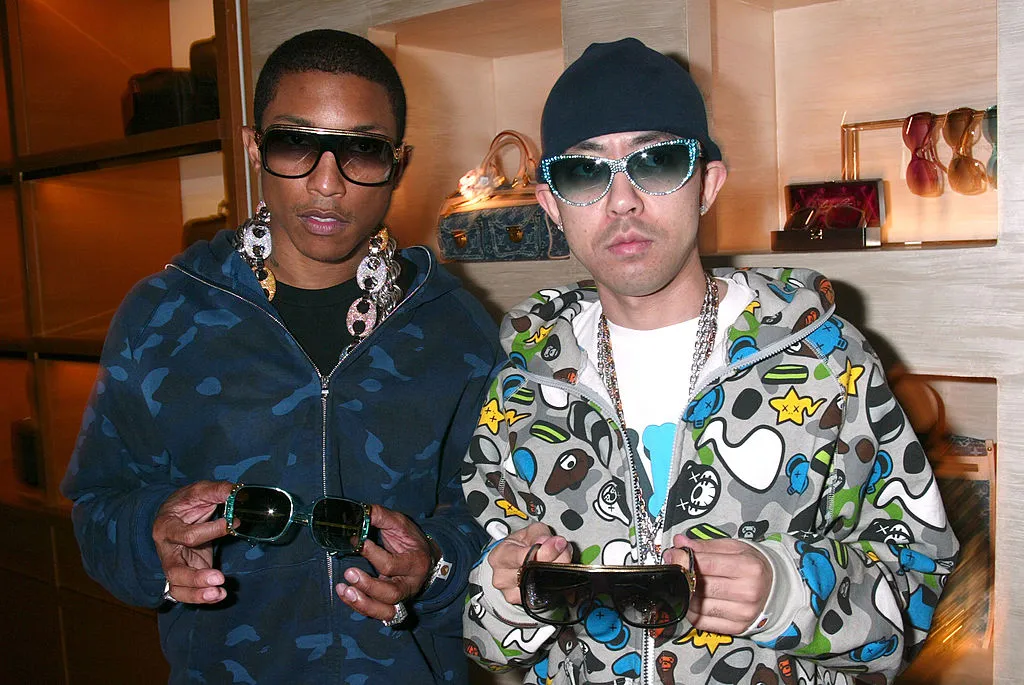
Pharrell Williams is once again collaborating with his long-time creative partner Nigo for a highly anticipated fall menswear collection at Louis Vuitton. The collection, set to be unveiled on Tuesday evening in Paris, marks the latest chapter in the duo’s longstanding creative relationship. Their partnership traces back to 2003, when they co-founded the iconic streetwear brands Billionaire Boys Club and Icecream, which played an instrumental role in pushing streetwear into the mainstream fashion consciousness.
In the lead-up to the official announcement, Williams had been teasing the collaboration on his social media, creating excitement among fashion enthusiasts and followers alike. On Tuesday morning, Louis Vuitton confirmed the collaboration with a post on Instagram, which included a visually striking image of Williams and Nigo. The photo, taken through a fisheye lens, shows the two sitting on the floor surrounded by bags, colourful varsity jackets, and sneakers, all set to the soundtrack of The Weeknd and Playboi Carti’s track “Timeless.” This creative visual speaks to the duo’s unique style and their ability to merge streetwear aesthetics with high fashion.
The collaboration between Williams and Nigo isn’t just about fashion; it’s the continuation of a decades-long friendship. Their journey together began when they co-founded Billionaire Boys Club (BBC) and Icecream, two brands that helped to cement streetwear’s influence in luxury fashion. While streetwear was once considered a niche subculture, Williams and Nigo’s innovation helped bring it into the spotlight, proving that high-end fashion and streetwear could coexist and even thrive together. Over the years, they’ve remained at the forefront of this movement, contributing to the evolution of both streetwear and luxury fashion.
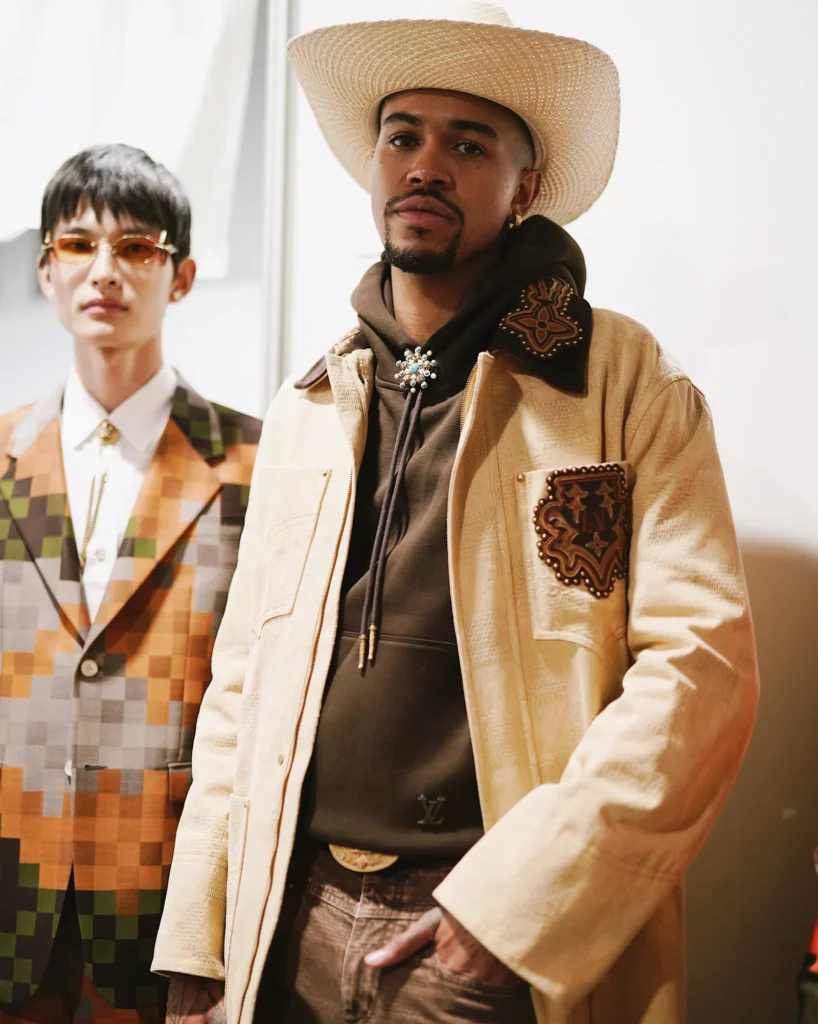
Louis Vuitton’s announcement of the collection comes just days before the highly anticipated fashion show, which is set to be livestreamed at 8 p.m. local time on Tuesday. The livestream will allow fashion fans around the world to witness the first look at the new designs created by Williams and Nigo. But the celebrations won’t end there—on Wednesday evening, the pair will also co-host a dinner to mark another milestone in their collaboration. The dinner will celebrate a new sale organised by Joopiter, the auction platform Williams launched in 2022. This event further solidifies the partnership between the two creatives, showing how their influence spans not only fashion but also art, culture, and entrepreneurship.
Nigo, a serial fashion entrepreneur, is no stranger to the world of high fashion. He first gained worldwide recognition as the founder of A Bathing Ape, or Bape, a streetwear brand that became synonymous with luxury, exclusivity, and urban culture. Though Nigo is no longer directly associated with Bape, his legacy in shaping the streetwear landscape is undeniable.
In addition to his work with Louis Vuitton, Nigo has enjoyed a successful career in other areas of the fashion world. Since 2021, he has served as the creative director at Kenzo, another prestigious brand under the LVMH umbrella, which also owns Louis Vuitton. His work at Kenzo has been met with critical acclaim, as he’s infused the brand with his signature aesthetic while maintaining its heritage. Beyond Kenzo, Nigo has worked as the creative director for Uniqlo’s UT range and continues to lead the Japanese brand Human Made. Last year, Williams became an advisor to Human Made, further deepening the bond between the two creatives. Williams also has a stake in the label as an investor, solidifying his role in Nigo’s ongoing journey in fashion.
This partnership between Nigo and Louis Vuitton isn’t the first time he has worked with the luxury brand. In 2020, Nigo collaborated with the late Virgil Abloh, Louis Vuitton’s former artistic director for menswear, to create a capsule collection. The success of that collaboration further emphasised the growing intersection of streetwear and luxury fashion.
As Williams and Nigo continue to shape the future of fashion, their collaboration for Louis Vuitton’s fall collection promises to be another exciting chapter in their shared legacy. With the collection’s unveiling just days away, all eyes will be on Paris to see how the duo blends streetwear influences with Louis Vuitton’s iconic luxury design, paving the way for future collaborations between streetwear icons and the luxury world. Whether through their work in fashion, music, or cultural entrepreneurship, Williams and Nigo are undoubtedly two of the most influential figures shaping the landscape of modern luxury fashion.
Fashion
Denim The Ever-Evolving Fabric of Democracy and Sustainability
Published
3 months agoon
January 8, 2025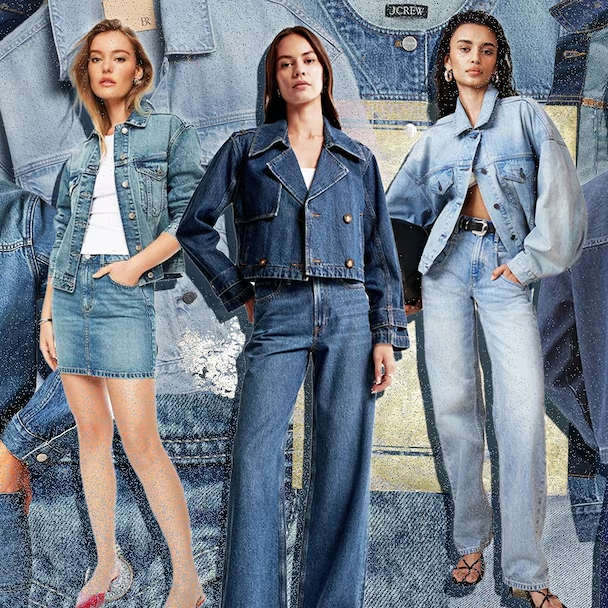
Few garments embody timelessness and versatility like denim. Worn across generations, genders, and cultures, jeans transcend social barriers and have cemented their place as a universal wardrobe staple. Denim’s rich history, rooted in workwear and rebellion, continues to evolve, blending tradition with innovation and sustainability.
A Growing Market with Ethical Challenges
Denim remains a robust market. As Rosey Cortazzi, global marketing director for Turkish denim supplier Isko, explains, “We’re extremely optimistic about the health of the denim market and have expanded our capacity to meet increased demand.” Isko has scaled its operations, reflecting denim’s enduring popularity. However, with growth comes responsibility. The denim industry, celebrated for its authenticity, must prioritise sustainability and worker welfare to uphold its values.
Fashion Revolution Week—held during the anniversary of the Rana Plaza collapse in Dhaka, Bangladesh—highlights the importance of transparency in the fashion supply chain. Brands like Dutch label MUD Jeans are leading the charge by integrating sustainable practices. MUD’s CEO, Bert van Son, emphasises the human aspect of production, stating, “It’s essential that the people who make our jeans live a good life.” MUD’s manufacturing processes save resources, recycle 95% of production water, and use post-consumer materials to create new jeans.
Levi’s, a brand synonymous with denim’s heritage, has demonstrated its commitment through the Worker Well-Being Initiative. This program, benefiting nearly 100,000 workers across 12 countries, goes beyond factory walls to improve lives through health education, family welfare programs, and financial empowerment. Levi’s plans to expand these efforts, aiming to positively impact 300,000 workers by 2025.
A Canvas for Innovation and Expression
Denim’s versatility has inspired designers to push boundaries. Ritwik Khanna, founder of Rkive City, transforms denim through patchwork, embroidery, and avant-garde tailoring, creating zero-waste designs from post-consumer materials. “Denim is magic,” Khanna says. “It can be anything and is built to last.” His work celebrates denim’s ability to carry stories, with clients repurposing garments from loved ones into new creations.
The material’s rebellious spirit—immortalised by icons like James Dean and Marilyn Monroe—continues to inspire. Denim historian Mohsin Sajid notes its enduring identity as a medium for breaking rules. High fashion has embraced this ethos, with brands like Valentino and Bottega Veneta reimagining denim in luxurious and avant-garde ways. Meanwhile, sustainability-focused innovations, such as using natural tints or 3D creases, showcase denim’s capacity for reinvention.
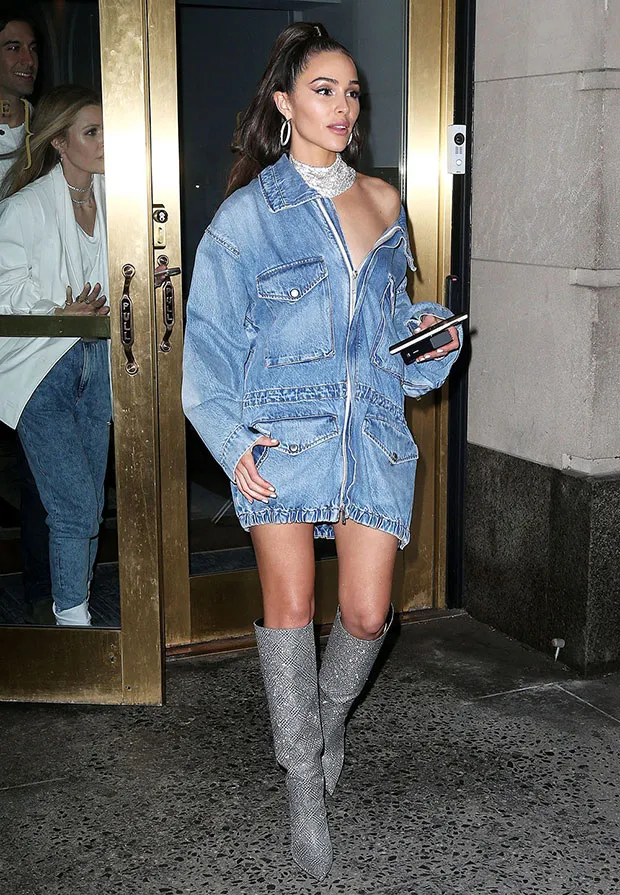
Denim as a Symbol of Sustainability and Democracy
Denim’s narrative is intrinsically linked to sustainability. As Ani Wells, a sustainability consultant, observes, denim’s “living fabric” quality lends itself to longevity and innovation. From recycled fibres to eco-friendly dyeing techniques, the industry is embracing circularity through the principles of reuse, repair, and recycle.
This adaptability makes denim a symbol of democracy in fashion. As Khanna aptly puts it, “Everyone understands it, from your grandparents to your children. It communicates with anyone.” Denim’s journey—from its origins in 19th-century workwear to its role in modern sustainability efforts—illustrates its enduring relevance and its power to reflect societal values.
The Future of Denim
As we move toward a more sustainable future, denim is poised to lead the conversation. Its capacity to balance heritage with innovation and its role as a cultural touchstone ensure its place at the forefront of ethical fashion. Denim’s evolution mirrors the wisdom of age, proving that authenticity, resilience, and adaptability are timeless qualities. Indeed, denim remains a fabric for the people, by the people.
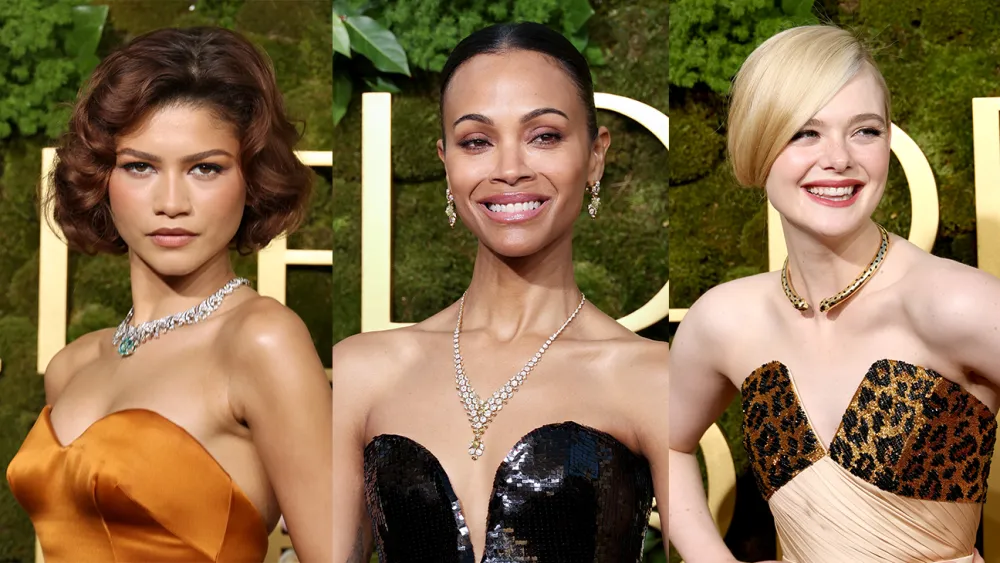
The 2025 Golden Globes brought together a dazzling display of Hollywood glamour, as stars hit the red carpet in jaw-dropping looks. From the sleek sophistication of tailored suits to the sweeping elegance of couture gowns, the evening was a showcase of true sartorial excellence. Amid the sea of classic black tuxedos, a select group of celebrities truly stood out, pushing fashion boundaries and evoking the timeless allure of old Hollywood. Here’s a closer look at the standout fashion moments from the Golden Globes, featuring the stars who owned the night with their impeccable style.
Hollywood’s finest worked tirelessly to bring a blend of modern elegance and vintage charm to the red carpet for the 2025 Golden Globes. Stylists spent the holiday season crafting perfect ensembles — from couture gowns to meticulously tailored suits, and adorned with diamonds that sparkled just as brightly as the stars themselves. One word resonated throughout the evening: “glamour.” Many of the women on the carpet paid homage to the iconic fashion of the 1950s and 60s, channeling the grace and sophistication of legendary actresses like Grace Kelly, Audrey Hepburn, and Faye Dunaway. These timeless looks, featuring satin gowns, exquisite jewelry, and evening gloves, felt not only captivating but equally optimistic, echoing the sentiment shared by director Jon M. Chu about the “radical act of optimism” that was the evening itself.
Among the gentlemen, color and accessories played a key role in bringing freshness to the traditional tuxedo. Andrew Scott made a statement in a bold blue Vivienne Westwood suit, while Jeff Goldblum’s beaded jacket added a touch of playful luxury. Although many men opted for classic black tuxedos, it was the refined details and thoughtful styling choices that elevated their looks to the next level.
Here’s a closer look at the top 12 stars who made unforgettable fashion statements at this year’s Golden Globes:
Zendaya in Louis Vuitton
Zendaya’s structured custom Louis Vuitton gown was the epitome of modern elegance. Crafted from double silk satin in a stunning saffron hue, the column bustier gown featured a pleated train and was paired with Bulgari high jewelry. The vivid blue paraiba tourmaline necklace added a brilliant contrast to her ensemble, showcasing Zendaya’s unique flair for combining classic glamour with bold, contemporary touches.
Nicole Kidman in Balenciaga
Nicole Kidman’s look was nothing short of mesmerizing in a backless Balenciaga gown embroidered with crystal rhinestones. The ’60s-inspired style, paired with a vintage hairstyle reminiscent of “Valley of the Dolls,” truly captured the essence of old Hollywood, while her Boucheron diamonds and Omega watch completed the high-fashion ensemble.
Margaret Qualley in Chanel
Margaret Qualley brought both sweetness and sophistication to the red carpet in a head-to-toe Chanel creation. Her embroidered white silk dress, adorned with delicate tulle ruffles and a black bow belt, was a perfect blend of femininity and high fashion. The handcraft of the dress, which involved 7,000 embroidery elements, was truly a work of art.
Allison Janney in Christian Siriano
Allison Janney exuded strength and grace in a custom Christian Siriano gown, which showcased her shoulders with its draped-sleeve design. The soft, baby crepe fabric complemented Janney’s poise, while her diamond jewelry and Jimmy Choo heels added the perfect finishing touches.
Elle Fanning in Balmain
Elle Fanning embraced classic glamour with a modern twist, donning a recreated 1953 Pierre Balmain gown. The belted ballgown, with its stunning animal-print bodice, was updated to reflect Fanning’s signature style. Cartier’s 18-karat yellow gold Panthère collection jewelry perfectly complemented the look.
Zoe Saldaña in Saint Laurent
Zoe Saldaña’s sequin gown from Saint Laurent, paired with a dramatic silk taffeta cape, was a nod to classic red carpet elegance with a modern flair. The chocolate-hued gown, accented with a statement necklace from Cartier, added an effortlessly chic touch to the evening.
Ariana Grande in Givenchy
Ariana Grande’s Givenchy gown, from Hubert de Givenchy’s 1966 collection, was a true homage to Audrey Hepburn’s timeless elegance. With white evening gloves, Swarovski jewels, and a vintage-inspired silhouette, Grande channeled the style icon with grace and modern sophistication.
Glen Powell in Giorgio Armani
Glen Powell’s look was the embodiment of cool-guy chic. Wearing a custom Giorgio Armani velvet jacket in dark chocolate brown, Powell paired it with black tuxedo trousers and a silk shirt. His choice of accessories — a Vacheron Constantin watch and Oliver Peoples sunglasses — added a suave finish to his red carpet appearance.
Cynthia Erivo in Louis Vuitton
Known for her bold style, Cynthia Erivo turned heads in a dramatic halter gown from Louis Vuitton. The black lace and silver sequins were meticulously hand-embroidered, while her lace boots and Roberto Coin diamonds completed the daring, yet refined look.
Andrew Scott in Vivienne Westwood
Andrew Scott’s eye-catching Vivienne Westwood suit was a standout moment on the red carpet. The duck-egg blue color sparked much debate, but the impeccable tailoring and minimalist accessories — including a pearl bracelet by Lagos — made this look a memorable one.
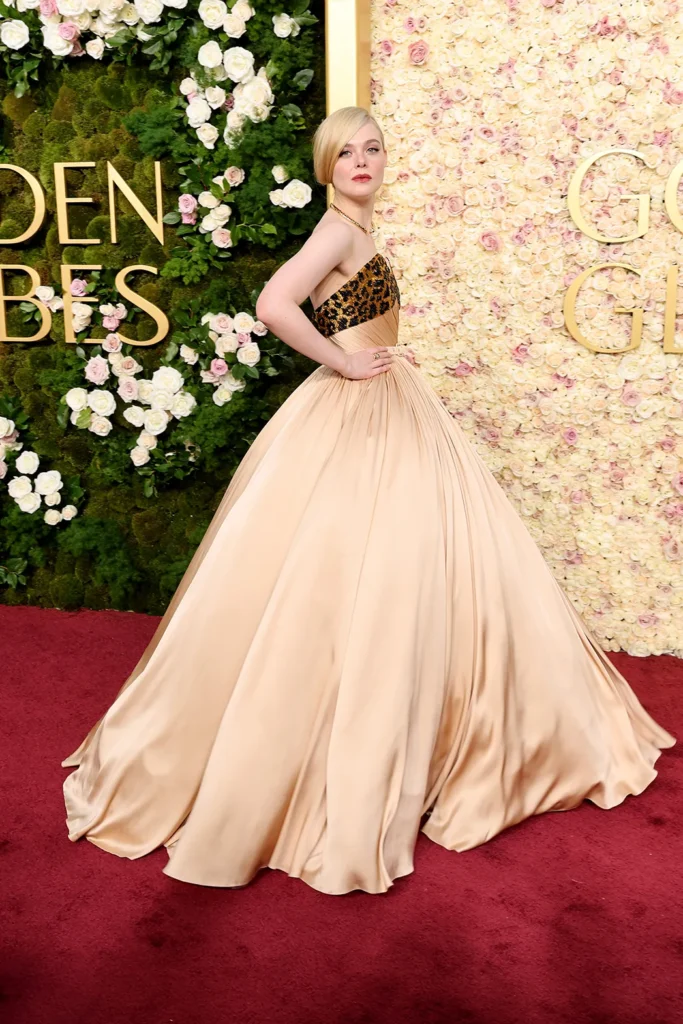
The 2025 Golden Globes red carpet was a masterclass in fashion, showcasing a blend of old Hollywood charm and modern sophistication. These stars not only wore stunning gowns and suits but also made bold fashion statements that will be remembered for years to come.
Trending
-

 Health4 years ago
Health4 years agoEva Savagiou Finally Breaks Her Silence About Online Bullying On TikTok
-

 Health3 years ago
Health3 years agoTraumatone Returns With A New EP – Hereafter
-

 Health3 years ago
Health3 years agoTop 5 Influencers Accounts To Watch In 2022
-

 Fashion4 years ago
Fashion4 years agoNatalie Schramboeck – Influencing People Through A Cultural Touch
-

 Fashion4 years ago
Fashion4 years agoThe Tattoo Heretic: Kirby van Beek’s Idea Of Shadow And Bone
-

 Fashion8 years ago
Fashion8 years ago9 Celebrities who have spoken out about being photoshopped
-

 Health4 years ago
Health4 years agoTop 12 Rising Artists To Watch In 2021
-

 Health4 years ago
Health4 years agoBrooke Casey Inspiring People Through Her Message With Music
-

 Tech2 years ago
Tech2 years agoGoogle Developer Conference to Unveil Latest AI Updates, Including PaLM 2 Language Model
-
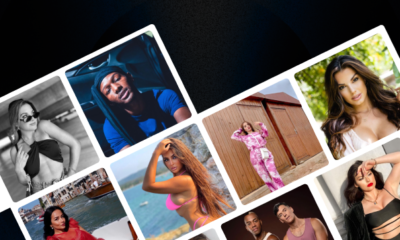
 Health3 years ago
Health3 years agoTop 10 Influencers To Follow This 2021
